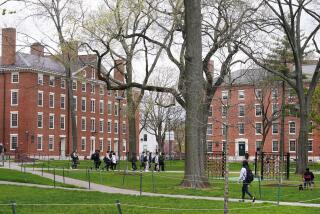Somewhere Out There
- Share via
“Our students,” says state school Supt. Bill Honig, “are more illiterate in geography than in anything else.” That indictment applies nationally. Tests given to high school and college students continue to expose an almost unbelievable level of geographic ignorance. Consider some representative examples: In recent years 95% of the freshmen tested at an Indiana college couldn’t locate Vietnam on a map. Fully 25% of Dallas high school seniors had no idea what country lies to the south of the United States. At Cal State Fullerton only 26% of the students were able to identify the Soviet Union as the world’s third most populous country.
What’s gone wrong? Geography as a separately taught subject long ago dropped out of the curriculum of most American public schools, becoming subsumed under the broader heading of social studies. A quarter of a century ago only 14% of secondary-school students were enrolled in geography courses. Bad enough, but things soon got worse. By the mid-1970s that number had dropped to 9%. The near-disappearance of geography teaching has been accompanied by a near-disappearance of specially trained geography teachers. A survey taken in 1982 found that only 10% of the country’s 5,000 upper-level geography teachers had majored in geography in college. Between 20 and 30% of the teachers had never taken any college course in geography.
The perplexing irony in all this is, of course, that as American involvement with the rest of the world has continued to grow and intensify, the awareness of an incresasing number of Americans about that world has shrunk. Three years ago a test of 12-year-olds found that about 20% couldn’t even find the United States on a world map. Among pupils in eight industrialized countries tested in geography Americans ranked a rather dismal fourth.
Change, happily, may at long last be on the way. New guidelines in California aim at requiring a renewed emphasis on geography throughout the public school years. In some grades and at some schools, geography courses are again becoming popular. The National Geographic Society is using its considerable resources to encourage the study of geography. Innovative technological means are under development to expand teaching tools and techniques.
One thing students will learn is that geography involves more than, say, remembering the capital of Delaware or determining if Hawaii is north or south of the Equator. Geography combines many disciplines to help provide an understanding of the world and its people. Once it held an honored and even central place in the curriculum. It’s a long way from returning to that status, but at least there are welcome signs that interest is spreading in trying to arrest and reverse the neglect of geography that for too long has prevailed in American education.
More to Read
Sign up for Essential California
The most important California stories and recommendations in your inbox every morning.
You may occasionally receive promotional content from the Los Angeles Times.













